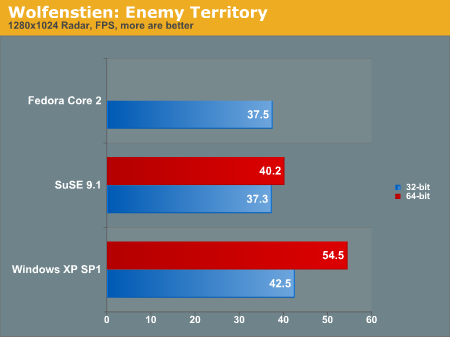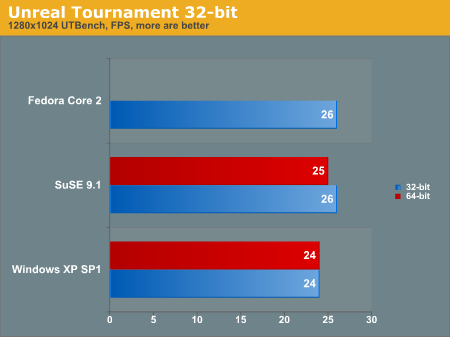AMD and Linux: Reaching for the 64-bit Trophy
by Kristopher Kubicki on July 12, 2004 12:05 AM EST- Posted in
- Linux
Gaming Performance
Unfortunately in Linux, we are restricted to only a few native games. Utilities such as WineX are bringing more and more games closer to the mainstream adoption that Windows already cherishes. However, we could spend an entire review alone looking solely at Wine based gaming, so we will save that for the future. In the meantime, we can take a look at the two native Linux games with which everyone should be familiar by now.For 64-bit Fedora Core 2, we were not able to install NVIDIA's graphics driver with the default kernel. Thus, their 64-bit tests must be omitted from the benchmark.
Wolfenstein: Enemy Territory is a free, stable, native game for Linux as well as a cornerstone of our Windows benchmark. Unfortunately, there is only a 32-bit version of the game, so we must settle with 32-bit performance benchmarks, even on our 64-bit platforms. Resolutions were set to 1280x1024 with default configurations. The timedemo that we are using can be downloaded here.
Frames per Second, more are better.

The significant differences in frame rates have to do more likely with optimizations of NVIDIA drivers rather than optimizations of NVIDIA hardware. Although iD and NVIDIA has put forth valiant efforts into making Linux competitive with Windows, the benchmark above hints that either (or both?) companies run extremely inefficient code for Linux.
The pride and joy of any Linux benchmark are the native 64-bit and 32-bit versions of Unreal Tournament. The timedemo (1280x1024) that we are using can be downloaded here.
Unreal Tournament 2004 32-bit

You may notice a lack of 64-bit operating system scores for UT2K4. We were particularly unnerved how difficult it was to get the 64-bit UT2K4 demo working in an out-of-the-box configuration. Both Fedora and SuSE required severe kernel hackings to get the NVIDIA 64-bit drivers working, which was, unfortunately, not the point of this analysis. Keep in mind, we have been seeing the UT2K3 demo run on 64-bit hardware on 64-bit operating systems almost as far back as the Opteron launch. We suspect that the number of users who actually play UT2K4 with 64-bit configurations are fairly selective.










29 Comments
View All Comments
Gatak - Monday, July 12, 2004 - link
Why do you not test Gentoo Linux. Sure, it needs to be compiled from scratch, but gives execptionally good performance.I realize it doesn't give a single equal platform to test over different hardware if you recompile all the time. However, you can make your installation to a A64 machine and then save the diskimage and use the same image on each machine you will use.
Good attempt to a 64bit Linux test =). There aren't many out there!
sprockkets - Monday, July 12, 2004 - link
I'm not sure how you are saying that you used RPMs for Lame that came with each distro. I use SuSE versions 8.1 - 9.1 and it has NEVER come with LAME by default. Neither is Mplayer bundled with SuSE 9.1, but I'm usually forced to use an RPM install of Mplayer since for some stupid reason it keeps complaining on configuring that I don't have the dev files of gtk installed, which I do. At least it would configure and install sometimes in SuSE 8.2.The only thing also I could at is with an Asue nForce 220 board SuSE worked ok with the drivers from nVidia installed by YaST in 8.2 (ver 9.0 would give me a nice blinking light on my monitor with the LiveEVAL cd), but with version 9.1 and the drivers for the 2.6 kernal, when I installed the drivers the whole computer would freeze seconds after just starting an 3d OpenGL screen saver. Couldn't kill X, only could hit the reset button.
Could you say how you installed the nVidia drivers, at least for SuSE 9.1?
roostercrows - Monday, July 12, 2004 - link
imo, linux needs a reality kick in the a**. there are millions of us that would like to use this "os" but over the last two years i have started and stopped repeatedly, it's just not ready for the masses of regular users. ie:# 2 "support fixes it USUALLY within a week or so". i agree, it's such a wasted opportunity for linux! just ask yourself what percentage of windows users are going to "recompile all of their source"?
OddTSi - Monday, July 12, 2004 - link
You guys conclude that "encoding, database, and rendering tests" show a distinct advantage with Linux over Windows after running a couple of tests that used programs that are more optimized for Linux. Wow, I'm speechless.jacob0401 - Monday, July 12, 2004 - link
Error on page 5? the second graph shows 2 fedor core labels, i tihnk one whouls be suse.KristopherKubicki - Monday, July 12, 2004 - link
ViRGE: Ill get back to you on that answer when i can make a more informed decision as to why the numbers were different.jiulemoigt: I was not blasting linux. i simply wanted to run benchmarks that we could all replicate. I would love to do an "AT Optimized" linux review, but i have a feeling it would be outdated quickly with the volitility of the OS.
Kristopher
jiulemoigt - Monday, July 12, 2004 - link
I'm confused by one thing that stands out more than anything else... I thought the whole point of Linux is you can recompile all of your source, yet the whole review blasts linux for not being perfect out of the box? I run both w2k and redhat (yes the expensive version) and most of the software works out of the box or support fixes it usually with in a week or so, but I have recompiled all and all source I had because you write an optimised complier once and use that on everything and makes things much more uniform. When I consider this takes less work that buildeing an image with all of the patches MS requires to function, is this not apples and oranges or at least bias toward windows? Yes I realize I'm not a normal user but how many hardcore gamers do NOT know how to install their own OS at least?ViRGE - Monday, July 12, 2004 - link
Kris, how(if at all) can you explain the differences in LAME performance between this set of benchmarks, and Anand's initial A64 benchmarks from the A64 launch(http://www.anandtech.com/cpuchipsets/showdoc.aspx?... Anand's numbers show a 30%+ boost in performance in LAME, so why aren't we seeing any such boost here?tribble - Monday, July 12, 2004 - link
The nVidia graphics driver incompatibility with Fedora Core 2 has been fixed with the latest driver (1.0-6106) released on June 30. The Fedora Core 2 kernel uses a 4K stack size (as opposed to the usual 8K stack).From the release highlights of the latest driver:
# Added support for 4k stack kernels.